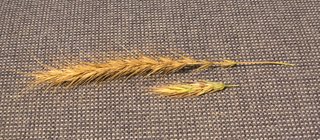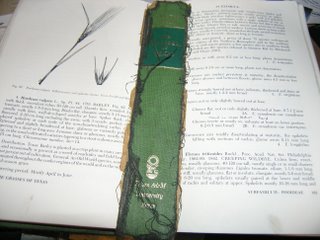How to Tell the CB Wild Ryes Apart, by C. Ovate
The Width of the Glumes
Many moons ago when I first began to study grasses, (early Druid training and the first plant family I was interested in), I relied upon “The Grasses of Texas” by Frank W. Gould to help me learn about the grasses. I still use that book quite a bit. I like it a lot, though, I must say, one can spend a lot of time figuring stuff out, due to typos in the keys. But nowadays my copy has those typos all corrected, maybe, and also features some interesting ancient commentary I made when I finally discovered that there were typos. For example, on p. 545 of my copy there is the spell, asshole, written in red pencil along with two big red ovals and arrows indicating how to correct for the typos by redistributing the text inside the red ovals to alternative locations as indicated by the arrows.
In addition to the typos, Dr. Gould’s lingo was sometimes confusing to the presumptive graminoidologist. An example:
_____
Glumes strongly bowed out at base
vs.
Glumes not or only slightly bowed out at base
_____
Hmmm. I said to myself once upon a time long ago. Whut the heck?
 Here’s a picture nearby of what Dr. Gould was trying to communicate to me in his key. The glumes of an Elymus virginicus are on the left, those of E. canadensis are on the right.
Here’s a picture nearby of what Dr. Gould was trying to communicate to me in his key. The glumes of an Elymus virginicus are on the left, those of E. canadensis are on the right.
 Here’s a couple of mature infloresences for comparison.
Here’s a couple of mature infloresences for comparison.
 Once the book cover falls apart you can use the spine cover part of it, for a bookmark. It took awhile, plus long term abuse, for this iteration to enter the book mark phase of book cover existence.
Once the book cover falls apart you can use the spine cover part of it, for a bookmark. It took awhile, plus long term abuse, for this iteration to enter the book mark phase of book cover existence.
______
Later
______
Say Crumby, wasn't there a novel spelled "The Width of the Glumes"?
Maybe Ray. Then also there was one spelled "Glume House", maybe.
Many moons ago when I first began to study grasses, (early Druid training and the first plant family I was interested in), I relied upon “The Grasses of Texas” by Frank W. Gould to help me learn about the grasses. I still use that book quite a bit. I like it a lot, though, I must say, one can spend a lot of time figuring stuff out, due to typos in the keys. But nowadays my copy has those typos all corrected, maybe, and also features some interesting ancient commentary I made when I finally discovered that there were typos. For example, on p. 545 of my copy there is the spell, asshole, written in red pencil along with two big red ovals and arrows indicating how to correct for the typos by redistributing the text inside the red ovals to alternative locations as indicated by the arrows.
In addition to the typos, Dr. Gould’s lingo was sometimes confusing to the presumptive graminoidologist. An example:
_____
Glumes strongly bowed out at base
vs.
Glumes not or only slightly bowed out at base
_____
Hmmm. I said to myself once upon a time long ago. Whut the heck?
 Here’s a picture nearby of what Dr. Gould was trying to communicate to me in his key. The glumes of an Elymus virginicus are on the left, those of E. canadensis are on the right.
Here’s a picture nearby of what Dr. Gould was trying to communicate to me in his key. The glumes of an Elymus virginicus are on the left, those of E. canadensis are on the right.  Here’s a couple of mature infloresences for comparison.
Here’s a couple of mature infloresences for comparison. Once the book cover falls apart you can use the spine cover part of it, for a bookmark. It took awhile, plus long term abuse, for this iteration to enter the book mark phase of book cover existence.
Once the book cover falls apart you can use the spine cover part of it, for a bookmark. It took awhile, plus long term abuse, for this iteration to enter the book mark phase of book cover existence.______
Later
______
Say Crumby, wasn't there a novel spelled "The Width of the Glumes"?
Maybe Ray. Then also there was one spelled "Glume House", maybe.

0 Comments:
Post a Comment
<< Home